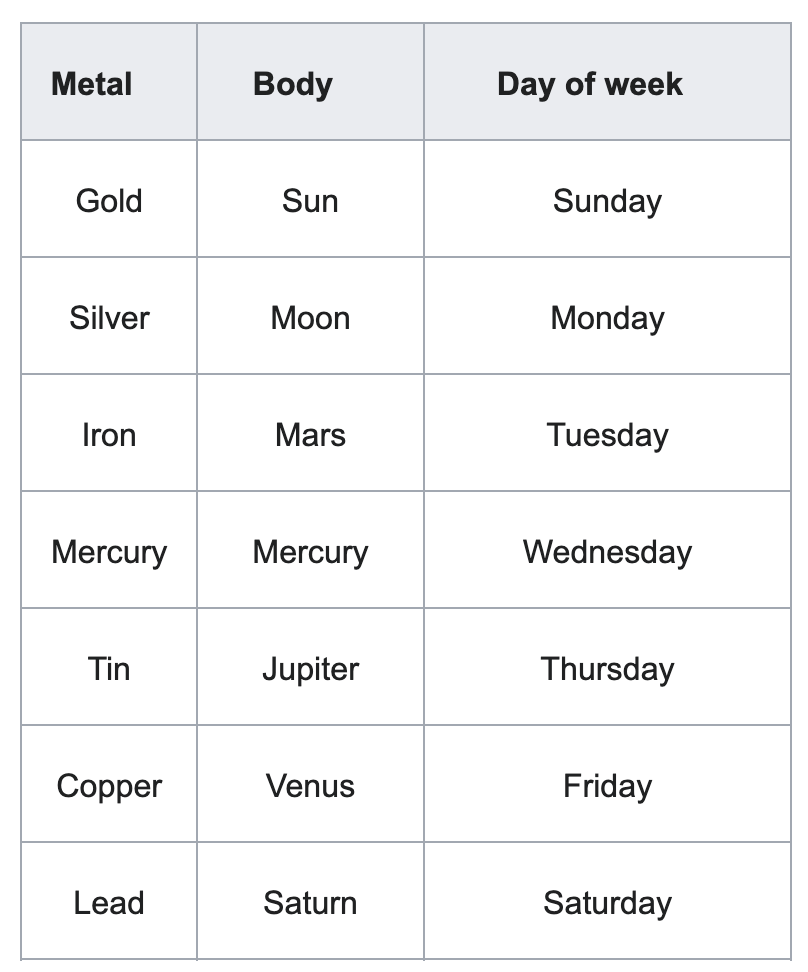I’m doing a show about gold at the Edinburgh Fringe. If you are in Scotland between August 4th and August 20th, plesase come. It’s at Panmure House in the room in which Adam Smith wrote Wealth of Nations. You can get tickets here.
Thousands of years before the dawn of civilisation, as prehistoric man hunted and gathered his way through the Stone Age, he might have come across six native metals - metals which occur in nature in a relatively pure state: silver, tin, lead, iron, copper and gold
He found gold in river beds - nuggets, mixed in with sediment, relatively easy to find, collect and shape. Gold doesn’t naturally combine with other metals in nature, so it is easy to identify. It shone, it glistened and so man adorned himself with it - as well as with bones, teeth, precious stones and shells.
Archaeological evidence from Spanish caves shows that gold was used by human societies as early as 40,000 years ago. This predates agriculture and the development of settled communities. It is the earliest example of human use of any kind of metal, and its purpose was as jewellery. The first records of man using copper came tens of thousands of years later. Lead, tin and iron’s first use, when advances in metallurgy took us into the Bronze Age, came even later. The use of gold for personal adornment was an established practice, even in prehistory. (Even copper’s first use was as jewellery). It is easy to make anthropological interpretations. Gold, a symbol of beauty, power and status, also indicates reproductive fitness: Look at me, I have access to this rare, shiny substance.
Stone Age man had the same basic instincts as we do today - the same urges, desires and compulsions: fear, desire, love, hate, greed. Nothing inspires greed like gold.
Survival is the most basic compulsion: to find water, food and shelter, for yourself and for those close to you. Then there is the survival of your species: the need to reproduce. If you are to survive, thrive and reproduce, so does the species as a whole grow stronger. Thus can an individual’s self-interest be good for the species as a whole.
What often goes unmentioned, though, is our instinct for beauty. What we find beautiful is also often good for us in some way. We are instinctively repulsed or alarmed by things that are dangerous – snakes, spiders, a cliff edge, loud noises - but things that aid our survival we find beautiful - the sound of running water, a fit and healthy potential mate, an open landscape with water, varied animal and plant life, good visibility and shelter. And we find gold beautiful.
The experience of beauty, whether derived from nature, art, music or even mathematics, correlates with activity in the emotional brain - in the medial orbito-frontal cortex. Beauty has long been associated by philosophers with truth and purity – also qualities commonly associated with gold. Our instinct for gold and the emotions it inspires from beauty to desire are basic. There has not been a culture in all history that did not appreciate the value of gold. It is a primal instinct. “The desire for gold,” said Wall Street trader Gerald Loeb, “is the most universal and deeply rooted commercial instinct of the human race.”
The artefacts found in those Spanish caves suggest that the people who lived in them had some basic skills. (Gold, which is relatively soft, is fairly easy to shape even using simple tools). Like shells, bones, stones, even hand axes, gold would have been used as reward as well as for decoration: as an expression of gratitude, as a prize for completing a task, for heroic deeds, as a tool in barter and exchange - as early money, in other words,. Even in prehistory gold was performing the role it has always performed - and always will: to store, display and exchange value.
Transcendent Treasure: Gold's Link to the Divine
Given its unique characteristics - beautiful, eternal, immutable - it is no surprise that gold found special status at the dawn of civilization. Our prehistoric ancestors cherished gold even before they were able to speak. Nor did that captivation fade after pre-history. Whether Asian, African, American, Mediterranean, Germanic or Celtic, gold occupies a place in the history and mythology of almost every ancient culture, the most valuable of all metals. As money, it was at the core of all their economies, however primitive.
Today we know of 90 metals or more. Many you’ve probably never heard of, let alone touched or seen. The likes of Cesium, Nihonium, Flerovium, Moscovium, Livermorium, Yttrium or Zirconium. Until the 13th century we knew of just seven: gold, silver, copper, tin, lead, iron, and mercury. There were also only seven known celestial bodies: the sun, the moon, Mars, Mercury, Jupiter, Venus and Saturn. Each metal came to be associated with a celestial body - silver with the moon, iron, rusty and red, with Mars, Mercury with its namesake, Jupiter with tin. With its glimmering yellow colour, gold was associated with the sun.
To the ancient Greeks, and other cultures besides, the sun was a golden chariot driven by the sun god, Apollo, across the sky each day. The Egyptian sun god Ra was depicted as a yellow blaze of gold. The Incas of South America believed gold to be the sweat or tears of the sun. The Latin word for gold, aurum, derives from Aurora, the goddess of dawn, who rose each morning to announce the sun’s arrival. The root of the word by which the Celts and Greeks referred to gold was the Sanskrit “Harat” which means colour of the sun. Plato and Aristotle both thought gold was actually obtained by combining intense sunlight with water.
The symbol for the Sun (a circle with a dot in it - ☉) was once the alchemical symbol for gold.
There are seven days of the week, too, and in many cultures so did each metal come to be associated with a day. Gold’s day, of course, was Sunday.
While silver was perceived as feminine, gold was a masculine metal, connected not just with the sun but with the lion, a symbol of strength. This association lives on today, from the lion rampant (standing on its hind legs) found on so many family crests to the three gold lions on the English coat of arms. Gold represented wealth, prosperity, authority and charisma. It was a symbol of knowledge and enlightenment, its radiant qualities mirroring the illumination provided by the sun. And so scholars and sages adorned themselves with it to reflect their intellectual and spiritual pursuits.
The sun's energy was thought to have infused gold with special healing properties. Ancient healers and priests often used gold in their remedies and elixirs, attributing its regenerative powers to the sun's life-giving energy. Wearing gold could help physical well-being and aid in recovery from ailments. The ancient Greek sun god Apollo was the god of healing and diseases, while his son, Asclepius, was the god of medicine. Apollo delivered people from epidemics, but could bring ill-health and deadly plague. Modern science confirms these instincts, with Vitamin D, which we get from sunlight, now being seen as so important for our general well-being. As the sun was a guardian against darkness and evil, so could gold ward off negative energies and offer spiritual protection, thus talismans and amulets were often made of gold.
Kings and queens decorated their bodies with gold to demonstrate their power, to impress, to dazzle, to command and to authenticate their god-like status. Because of gold’s imperishable characteristics many imbued it with divine qualities, and it is forever associated with the eternal, the permanent and the incorruptible. From Hercules’ quest for the Golden Apples of Hesperides (which bestowed immortality) to King Arthur’s knights’ search for the Holy Grail to Frodo’s attempt to destroy the precious ring of power in The Lord of the Rings, gold has become a symbol of incorruptible quest, purity, ambition and purpose. The golden thread left for Theseus by his lover Ariadne to help him escape the minotaur and the labyrinth symbolises an enlightened or clear path. Even today the young student gets a gold star, the athlete a gold medal. It is a symbol of achievement.
In Scotland between Aug 4th and Aug 20? I’m doing a show about gold at the Edinburgh Fringe. It’s at Panmure House in the room in which Adam Smith wrote Wealth of Nations. You can get tickets here.
Buying gold?
Interested in buying gold to protect yourself in these uncertain times? My recommended bullion dealer is The Pure Gold Company, whether you are taking delivery or storing online. Premiums are low, quality of service is high. They deliver to the UK, US, Canada and Europe, or you can store your gold with them. More here.
This article first appeared at Moneyweek.














